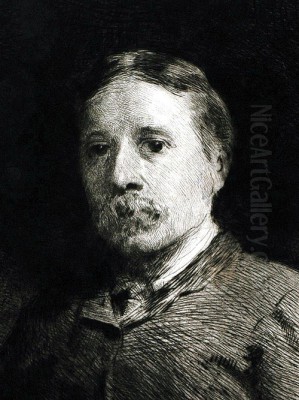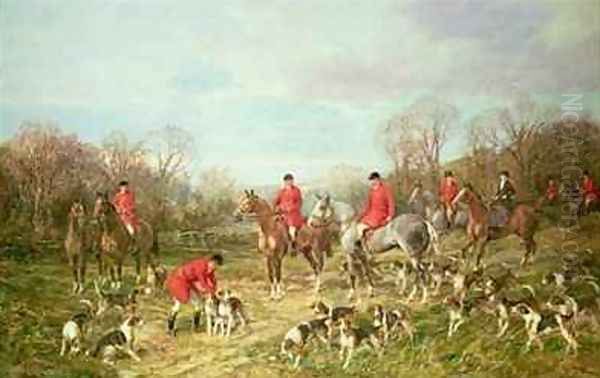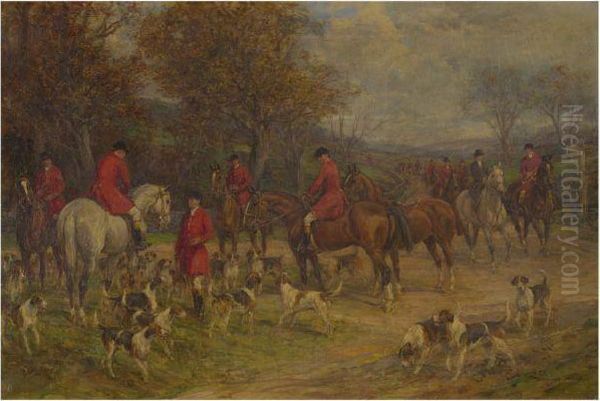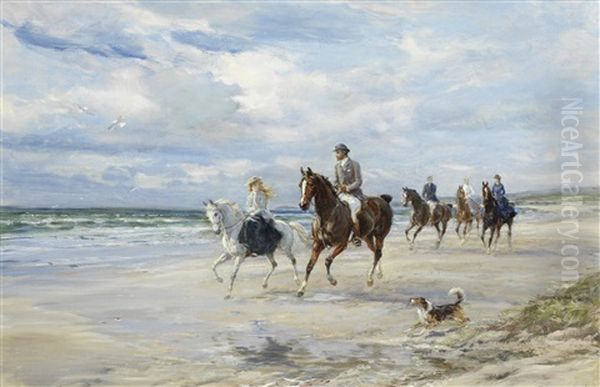
Heywood Hardy stands as a significant figure in British art during the late Victorian and Edwardian periods. Born into an artistic family and forging his own path through dedication and international study, Hardy became renowned for his evocative depictions of English country life, particularly his masterful paintings of animals, sporting scenes, and elegant social interactions. His work, blending elements of Naturalism and Romanticism with a keen eye for detail and movement, captured a specific vision of England that resonated deeply with his contemporaries and continues to find appreciation today. This exploration delves into the life, career, artistic style, and legacy of Heywood Hardy, placing him within the rich tapestry of 19th and early 20th-century art.
Early Life and Artistic Formation
Heywood Hardy was born in Chichester, West Sussex, England, on November 25, 1842. Artistry was ingrained in his family heritage. His father, James Hardy Sr. (1801-1879), was a landscape painter of note, providing young Heywood with an immediate immersion into the world of visual arts. Furthermore, his elder brother, James Hardy Jr. (1832-1889), also pursued an artistic career, gaining recognition for his skillful depictions of animals, particularly horses and dogs, often set within the dynamic context of hunting scenes across England and Scotland. Heywood was the youngest of ten children, growing up in an environment where painting was a part of daily life and professional practice.
Despite this artistic lineage, Heywood Hardy's entry into a full-time painting career was marked by youthful independence. Around the age of seventeen, reportedly after a disagreement with his father, he left the family home. This early departure necessitated self-reliance. Hardy began his professional journey by undertaking painting commissions, producing works he could sell to sustain himself. This period likely honed his skills through practical application and instilled a strong work ethic that would characterize his long career.

Recognizing the need for formal training to refine his burgeoning talent, Hardy saved enough money from his early commissions to pursue studies abroad. In 1864, at the age of 22, he traveled to Paris, the undisputed center of the art world at the time. This move was pivotal. He enrolled at the prestigious École des Beaux-Arts, securing a place in the studio of Pierre-Isidore Pils (1813-1875). Pils was known for his historical and military scenes, often large-scale canvases depicting battles with academic precision and dramatic flair. Studying under Pils provided Hardy with rigorous academic training in drawing, composition, and technique, a foundation that would underpin his later work, even as his style evolved.
His time in Paris exposed Hardy not only to academic tradition but also to the revolutionary artistic currents sweeping the city. The Realism championed by artists like Gustave Courbet and the burgeoning Impressionist movement, with figures such as Edgar Degas beginning to explore modern life and transient effects of light, were part of the artistic atmosphere. While Hardy never fully embraced Impressionism's broken brushwork or avant-garde subject matter, the emphasis on capturing movement, light, and atmosphere undoubtedly left an impression, particularly visible in his later dynamic equestrian scenes.
Establishing a Career in London
After his formative years of study in Paris, Heywood Hardy returned to England, eventually settling in London to establish his professional career. He initially resided in St John's Wood, an area popular with artists. Building upon his training and natural inclinations, he began to specialize as an animal painter. This genre was exceptionally popular in Victorian Britain, with artists like Sir Edwin Landseer (1802-1873) achieving immense fame and fortune through their often sentimentalized depictions of animals. Hardy entered this field with a strong technical grounding and a developing personal style.
Hardy quickly gained recognition for his skill. His paintings began to appear in major exhibitions, including those at the Royal Academy of Arts in London, a crucial venue for establishing an artist's reputation. His subjects often revolved around horses, dogs, and the sporting life associated with the English countryside – fox hunting, racing, and leisurely rides. These themes appealed greatly to the landed gentry and the affluent middle classes, providing a steady stream of commissions and sales.
Beyond easel painting, Hardy diversified his output by working as an illustrator. He contributed drawings to prominent illustrated periodicals of the day, such as The Illustrated London News and The Graphic. These publications enjoyed wide circulation, bringing Hardy's work to a broad audience and further enhancing his public profile. His ability to capture narrative moments and detailed scenes made him well-suited for illustration, complementing his painting practice.

His growing success allowed him to move within prominent artistic circles. He became associated with various art societies, which were vital for networking, exhibition opportunities, and professional validation. His talent was acknowledged through election to several prestigious bodies. He was a founding member of the Royal Society of Portrait Painters, the Royal Society of Painter-Etchers and Engravers, and the Royal Institute of Oil Painters, affiliations that underscored his versatility across different media and genres, including portraiture and printmaking alongside his primary focus on animal and sporting subjects.
Artistic Style and Themes
Heywood Hardy's artistic style is best characterized as a blend of Naturalism and Romanticism, infused with the dynamism observed in some contemporary French art. He possessed a remarkable ability to render animals, particularly horses, with anatomical accuracy and a sense of vitality. His approach was rooted in careful observation, a hallmark of Naturalism, striving for a truthful representation of form, texture, and movement. This distinguishes his work from the sometimes overly anthropomorphic or sentimental approach of predecessors like Landseer.
However, Hardy's paintings often transcend mere factual depiction. There is a strong Romantic sensibility in his choice of subjects and their presentation. The sweeping landscapes of the English countryside, the drama and energy of the hunt, the elegance of riders and their mounts – these are often imbued with an idealized quality, celebrating a traditional, harmonious vision of rural life. He captured the pageantry and social rituals associated with equestrian pursuits, presenting them with an appealing vibrancy.
His time in Paris, particularly his exposure to artists interested in capturing movement, seems to have influenced his handling of equestrian subjects. While not an Impressionist in technique, his paintings often convey a sense of immediacy and action. The galloping horses, the focused expressions of riders, the scattering hounds – all are rendered with a fluidity that suggests direct observation of motion. Artists like Edgar Degas were contemporaneously exploring similar themes of horses and movement in Paris, and while their styles differed, the shared interest in capturing dynamic animal forms is notable.
Hardy's technical skill was considerable. His brushwork was typically controlled and precise, allowing for fine detail in rendering the textures of animal coats, foliage, and clothing. He had a sophisticated understanding of light and shadow, using it effectively to model forms, create atmosphere, and enhance the narrative drama of his scenes. Whether depicting the crisp light of a morning ride or the dappled sunlight filtering through trees during a hunt meet, his handling of light contributes significantly to the painting's mood and realism. His palette was generally rich and naturalistic, reflecting the colours of the English landscape and the attire of his subjects.
Key Subjects and Representative Works

Heywood Hardy's oeuvre is dominated by several recurring subjects, each handled with his characteristic blend of accuracy and evocative atmosphere.
Equestrian and Sporting Scenes: This is perhaps the genre for which Hardy is best known. His paintings frequently depict fox hunting – the meet, the chase, the return. Works like "The Meet" or "Returning from the Hunt" capture the social excitement and traditions surrounding the sport, as well as the physical energy of horses and hounds in motion. He portrayed elegant figures on horseback, enjoying leisurely rides through picturesque countryside settings, as seen in paintings like "A Morning Ride." These scenes appealed to patrons who participated in or admired this aspect of aristocratic and gentry life. His depiction of horses was particularly admired, comparing favorably with earlier masters of sporting art like George Stubbs (1724-1806) in anatomical understanding, though Hardy's style reflected later Victorian sensibilities. His work in this area also invites comparison with later sporting artists such as Sir Alfred Munnings (1878-1959), who continued the tradition into the 20th century.
Animal Studies: Hardy was a consummate animal painter beyond the context of sport. He produced detailed studies of horses, dogs, and other animals, often showcasing their individual character and form. His trip to Egypt provided him with opportunities to study exotic wildlife, notably lions. He reportedly made detailed anatomical drawings of lions, possibly based on studies at zoos or during his travels, reflecting a scientific interest underpinning his artistic practice. This dedication to understanding animal anatomy aligns him with other great animal painters like the French artist Rosa Bonheur (1822-1899), who also emphasized anatomical accuracy. His sensitive portrayal of dogs, often companions in his hunting or domestic scenes, also echoes the work of his brother, James Hardy Jr., and the broader British tradition of animal portraiture.
Genre and Social Scenes: While animals often featured prominently, Hardy also painted genre scenes depicting aspects of rural and upper-class life. These might include figures in interiors, stable scenes, or social gatherings where interactions between people, and often their animals, were the focus. These works provide glimpses into the social customs and environments of his time, rendered with attention to detail in setting and costume.
Portraits: As a founding member of the Royal Society of Portrait Painters, Hardy undertook portrait commissions. His patrons included notable figures and families, such as Lieutenant-Colonel Windham Murray, the Marquis of Zetland, and the Sitwell family of Renishaw Hall. While perhaps less famous than dedicated portraitists like John Singer Sargent (1856-1925) or James McNeill Whistler (1834-1903), with whom he shared membership in London's art circles, Hardy's portraits were competent and valued by his clients, often incorporating their favoured animals or country settings.
Landscapes: Although primarily known for his figurative and animal work, Hardy's paintings invariably feature landscape settings. He depicted the rolling hills, woodlands, and fields of the English countryside with sensitivity, creating convincing backdrops that enhance the atmosphere of his primary subjects. These landscapes contribute significantly to the overall Romantic feel of his work, celebrating the beauty of rural England.
Travels and Broadening Horizons
While deeply rooted in the English landscape and social scene, Heywood Hardy sought inspiration and knowledge beyond Britain's shores. His most significant journey abroad, after his initial studies in Paris, was a trip to Egypt. This voyage, likely undertaken in the 1870s, was driven by his desire to study wildlife not native to England, particularly large cats. The Victorian era saw a surge of interest in exploration and the natural history of distant lands, and Egypt, with its ancient history and distinct fauna, held a particular fascination.
In Egypt, Hardy dedicated time to observing and sketching animals, most notably lions. His goal was not just to capture their appearance but to understand their anatomy and movement, knowledge that would enhance the realism and power of his animal depictions, whether set in exotic locales or transposed into allegorical or zoo settings back home. This pursuit of direct observation and anatomical study aligns him with a scientific approach to animal painting seen in artists striving for accuracy.
This experience likely broadened his artistic perspective, exposing him to different light conditions, landscapes, and cultures. While Egyptian themes do not dominate his overall output, the studies conducted there undoubtedly enriched his understanding of animal forms and potentially influenced his handling of light and atmosphere in subsequent works. The dedication required for such a journey underscores his commitment to his craft and his pursuit of excellence in animal representation.
Professional Associations and Recognition
Heywood Hardy's talent and professionalism earned him significant recognition within the London art establishment. His active participation in various art societies was crucial to his career development and standing. He was not merely a member but often a founding member, indicating his proactive role and the respect he commanded among his peers.
His affiliation with the Royal Academy of Arts was vital. Regularly exhibiting paintings there from the 1860s onwards provided visibility and critical assessment. Acceptance into the RA's annual exhibitions was a benchmark of success for artists of the period.
Hardy was a founding member of the Royal Society of Painter-Etchers and Engravers (founded 1880), highlighting his proficiency in printmaking techniques, particularly etching. This medium allowed for wider dissemination of his images and showcased his skill in linear composition and tonal variation.
He was also a founding member of the Royal Institute of Oil Painters (founded 1882), demonstrating his commitment to the medium of oil painting and his association with fellow practitioners dedicated to promoting its excellence.
Furthermore, his role as a founding member of the Royal Society of Portrait Painters (founded 1891) confirmed his status as a capable portraitist alongside his fame as an animal and sporting artist. This society aimed to elevate the status of portrait painting in Britain.
These memberships placed Hardy firmly within the mainstream of the London art world. He moved in circles that included some of the most famous artists of the day. While direct collaborations might have been limited, he would have known and interacted with figures like the fashionable portraitist John Singer Sargent, the aesthetic pioneer James McNeill Whistler, and leading academicians such as Frederic Leighton (1830-1896) and Lawrence Alma-Tadema (1836-1912). His work offered a popular and skilled alternative to the high classicism of Leighton or the aesthetic experiments of Whistler, focusing instead on themes deeply rooted in British tradition and country life. He also worked alongside other successful animal painters like Briton Rivière (1840-1920), who similarly combined anatomical accuracy with narrative interest.
Hardy received numerous commissions from wealthy patrons, including aristocracy and landowners who wished to have their portraits, their estates, their prize animals, or their participation in sporting events immortalized. This patronage provided financial stability and further cemented his reputation.
Context: Hardy and His Contemporaries
To fully appreciate Heywood Hardy's contribution, it's essential to place him within the context of the vibrant and diverse art scene of Victorian and Edwardian Britain. This era witnessed a complex interplay of established academic traditions, reform movements like the Pre-Raphaelite Brotherhood (though its main impact predated Hardy's peak), the rise of Aestheticism, and increasing engagement with continental developments like Realism and Impressionism.
Hardy navigated this landscape successfully by carving out a niche that combined technical skill, popular subject matter, and a style that was accessible yet sophisticated. He was less radical than Whistler, whose focus on "art for art's sake" challenged Victorian narrative conventions. He was less overtly classical or mythological than figures like Lord Leighton or Edward Poynter. His work did not typically engage with the social commentary found in the paintings of Social Realists like Luke Fildes or Hubert von Herkomer.
Instead, Hardy excelled in genres that celebrated traditional aspects of British identity and landscape. His sporting art continued a lineage tracing back to George Stubbs and Ben Marshall, updated with a late Victorian sensibility for detail and atmosphere. His animal painting stood alongside the work of contemporaries like Briton Rivière, offering detailed and often dramatic portrayals, though generally avoiding the overt sentimentality sometimes found in Landseer's work.
His connection to French art, particularly his training under Pils and his likely awareness of Impressionism, placed him in a position to incorporate subtle modern influences – particularly in the suggestion of movement and light – without abandoning the representational clarity valued by his patrons and the exhibition-going public. He represented a successful strand of British art that absorbed some continental lessons while remaining firmly rooted in native tastes and traditions.
His work as an illustrator for popular magazines also connected him to a broad audience, making him a familiar name beyond the elite circles of collectors and gallery visitors. This dual practice as painter and illustrator was common among successful Victorian artists, including figures like John Everett Millais (1829-1896) in his earlier career.
The Clymping Church Panels: Late Work and Controversy
Late in his long career, at the age of 84, Heywood Hardy undertook a significant and somewhat unusual commission: a series of eight large paintings depicting biblical scenes for St Mary's Church in Clymping, West Sussex. Completed around 1926, these panels represent a departure from his usual subject matter of sporting and animal scenes, showcasing his versatility and engagement with religious themes in his later years.
The Clymping panels depict key moments from the life of Christ, rendered in Hardy's characteristic style, albeit applied to sacred subjects. The figures are clearly drawn, the compositions carefully arranged, and the settings often incorporate landscape elements reminiscent of his secular work. These paintings were intended as a significant addition to the church's interior decoration.
However, the Clymping panels became a source of controversy, arguably the most debated aspect of Hardy's career. The reasons for the controversy are not always clearly documented but likely stemmed from several factors. By the 1920s, artistic tastes had shifted significantly. Modernist movements had challenged traditional representational styles, and Hardy's relatively conservative, narrative approach to biblical scenes might have seemed outdated or inappropriate to some critics or parishioners. There may also have been specific objections to his interpretations or the perceived realism of the depictions within a sacred context.
Despite the controversy, the Clymping panels remain in the church today. They stand as a testament to Hardy's enduring skill and ambition even in old age, and his willingness to tackle large-scale, demanding religious subjects. They offer a fascinating counterpoint to his more familiar body of work, revealing a different facet of his artistic interests and perhaps his personal faith. The controversy itself highlights the changing artistic and religious sensibilities of the early 20th century.
Legacy and Collections
Heywood Hardy died in 1933 in West Sussex, leaving behind a substantial body of work and a solid reputation, particularly as a painter of animals and English country pursuits. While perhaps overshadowed in critical discourse by more avant-garde contemporaries during the mid-20th century, his work has maintained enduring appeal, especially among collectors of sporting art and those interested in depictions of traditional English life.
His paintings captured a specific era and lifestyle with skill and charm. The accuracy of his animal depictions, the vibrancy of his hunting scenes, and the elegance of his equestrian portraits continue to be admired. His work provides a valuable visual record of the social customs, attire, and landscapes of late Victorian and Edwardian England.
Heywood Hardy's paintings are held in numerous public and private collections. Notably, Manchester Art Gallery in the UK holds examples of his work. While perhaps not as ubiquitous in major international museums as some of his contemporaries, his paintings frequently appear at auction, where they command respectable prices, indicating a continued market appreciation for his skill and chosen subjects. His etchings also survive, demonstrating his proficiency in printmaking.
His legacy lies in his contribution to the genres of animal and sporting art in Britain. He successfully blended academic training with influences from contemporary art movements, creating a style that was both accomplished and popular. He remains a key figure for understanding the artistic tastes and cultural values of his time, a chronicler of a world centered around the horse, the hound, and the rituals of the English countryside.
Conclusion
Heywood Hardy's long and productive career spanned a period of significant change in the art world. From his beginnings in an artistic family and his formative studies in Paris to his established position within the London art scene, he consistently produced work characterized by technical skill, keen observation, and an affinity for the subjects of English rural life. As a master painter of animals, particularly horses, and a vivid chronicler of sporting and social scenes, he captured an enduring vision of England. While his late religious works sparked controversy, they underscore his versatility. Through his paintings, etchings, and illustrations, Heywood Hardy created a rich and lasting legacy, securing his place as an important and appealing figure in British art history.